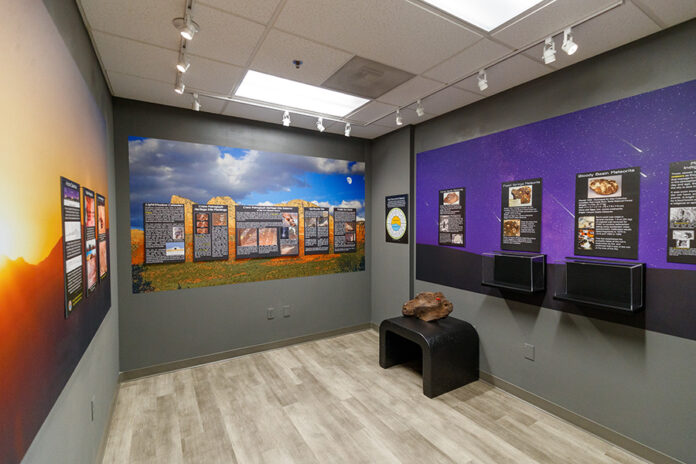The Verde Valley Archaeology Center opened its new exhibit, “Indigenous Cosmology and Astronomy,” on Wednesday, April 12. Archaeoastronomy, the study of ancient astronomy, describes how early people used stellar cycles to track and map time.
“Throughout history and across cultures, the sky has been a place of wonder and awe,” said Monica Buckle, the center’s executive director, in a statement. “Anthropological research has confirmed that the regularity of the motions of celestial objects has helped humans to orient themselves in time and space, a critical survival tool. Instances of this knowledge have been documented in the Verde Valley.”
The exhibit’s press release states: “The way the sun impacts the rhythm of our daily lives and the changing seasons has been recognized since time immemorial. We are not so distant from our forebears who first gazed into the cosmos, studied its celestial geometry and applied astronomical wisdom to their lives. Astronomy gave Native American and indigenous people a new perspective on time — understanding the cycles of the sun and the moon allowed these people to look into the future with confidence while providing a stable framework. We are fortunate in the Verde Valley to have present-day descendants among the Hopi, Yavapai and Apache who continue to practice ancient sky lore through stories and rituals.
“Archaeoastronomy is a multi-disciplinary subject that includes archaeology and astronomy, as well as subjects as diverse as geology, climatology, engineering, art and religion.
“Archaeoastronomy opens a window to the past, offering insight into the hopes and aspirations of our predecessors, as well as revealing many of their struggles to survive. The ancient development of complex systems of knowledge that combined astronomy with spiritual values occurred throughout the world, independently, but all were based on the same key building blocks of the sun, moon, stars and their predictable paths across the sky.”
The exhibit will focus on applied astronomy as practiced in the Verde Valley. Farmers used the sun’s cycle to create a calendar to time the planting of crops and religious leaders used the sun and moon to time rituals. It will explore two early methods of marking time, including the observation of the sunrise or sunset along the horizon enhanced with images carved or painted onto a landscape that could interact with light and shadows.
Time could also be determined by following the phases of the moon and various constellations that appear at different times and locations throughout the year.
The museum commissioned four katsinas for the gallery by traditional Hopi carver Darance Mak’wesa Chimerica that relate to the celestial realm.
“This exhibit provides a glimpse into some of these discoveries that leads to a greater appreciation of the technological skills of the Hopi ancestors,” Buckle said.
Other April events at the VVAC will include a course in archaeoastronomy that complements the exhibit at 10 a.m. on Saturday, April 15, taught by Director Emeritus Ken Zoll. The class will cover current literature on archaeoastronomy in the Southwest, issues related to naked-eye observations and the basic recording techniques of the Hisat’sinom people, also known as the Anasazi or Ancient Puebloans.
On Saturday, April 22, at 11 a.m., the center will host an Earth Day talk with Yolanda Hart Stevens, an artist and community activist of the Yuman peoples of the Colorado River. Stevens will discuss the importance of the mesquite tree and the environmental challenges affecting American Indian communities.



